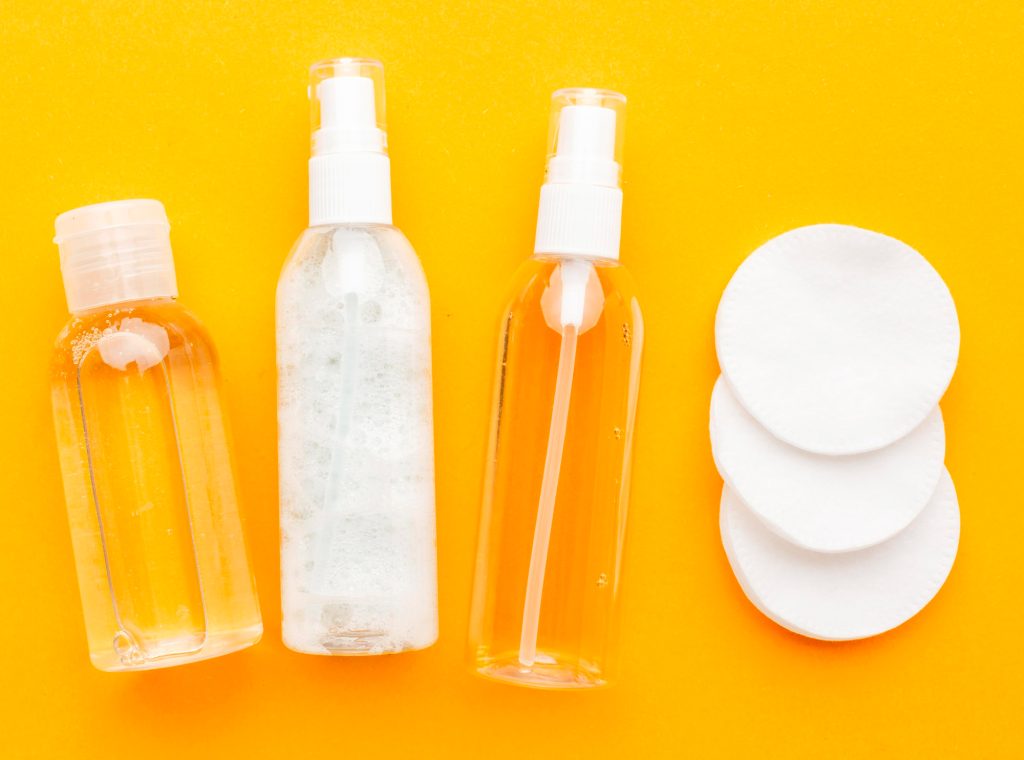Discover the key distinctions between chemical and physical sunscreens in this informative article.
Understanding the Difference Between Chemical and Physical Sunscreens
When it comes to sunscreen, it’s important to know your stuff. There are so many choices out there, it can be overwhelming! But fear not, we’re here to break it down for you. In this article, we’ll be diving deep into the world of sunscreen and exploring the differences between chemical and physical sunscreens. So grab your shades and let’s get started!

The Basics of Sunscreen
Before we can delve into the differences, let’s start with the basics. What exactly is sunscreen? Well, sunscreen is a product that helps protect your skin from the harmful effects of the sun’s rays. It acts as a shield, absorbing or reflecting those pesky UV rays before they can penetrate your skin. In short, it’s like a magical force field for your body. Pretty cool, huh?
But how does sunscreen actually work? When you apply sunscreen to your skin, it forms a thin, protective layer that acts as a barrier between your skin and the sun. This layer contains active ingredients that work to absorb or scatter the UV rays, preventing them from causing damage to your skin cells. Some sunscreens even contain additional ingredients that provide antioxidant protection, helping to fight against free radicals that can accelerate skin aging.
What is Sunscreen?
Sunscreen is specially formulated to protect your skin from the sun’s rays. It comes in various forms, such as lotions, creams, gels, and sprays. Each form has its own unique texture and application method, allowing you to choose the one that suits your preferences and needs. For example, lotions are typically lightweight and easy to spread, while creams provide a thicker, more moisturizing barrier.
When it comes to choosing a sunscreen, you’ll also come across different sun protection factors (SPF). SPF measures the level of protection a sunscreen provides against UVB rays, which are primarily responsible for sunburn. The higher the SPF, the greater the level of protection. However, it’s important to note that SPF only indicates protection against UVB rays and not UVA rays, which can also cause skin damage. Look for broad-spectrum sunscreens that offer protection against both types of rays.
Why is Sunscreen Important?
Sunscreen is not just an optional extra—it’s a vital part of any skincare routine. The sun emits different types of rays, including UVA and UVB. These rays can cause a whole host of problems, from sunburn and premature aging to more serious issues like skin cancer. Applying sunscreen helps to reduce your risk and keep your skin healthy and happy.
Regular use of sunscreen can also help prevent the development of dark spots and hyperpigmentation, which can be caused by sun exposure. By protecting your skin from the sun’s harmful rays, you’re giving it a fighting chance to maintain an even and radiant complexion.
It’s important to note that sunscreen should be used year-round, regardless of the weather or season. Even on cloudy days, UV rays can still penetrate through the clouds and reach your skin. So, whether you’re lounging on the beach in the summer or going for a winter hike, don’t forget to slather on that sunscreen!
Understanding UV Rays
Now that we’ve covered the basics of sunscreen, let’s dig a little deeper into the world of UV rays. They’re the ones responsible for all the trouble, after all.
UV rays, also known as ultraviolet rays, are a form of electromagnetic radiation that comes from the sun. They are invisible to the naked eye but can have harmful effects on our skin when we are exposed to them for extended periods of time.
The Different Types of UV Rays
There are two main types of UV rays: UVA and UVB. UVA rays have a longer wavelength and can penetrate deep into the skin, causing long-term damage and leading to premature aging. These rays are present all year round, even on cloudy days, and can penetrate through glass, making it important to protect your skin even when you’re indoors.
UVB rays, on the other hand, have a shorter wavelength and are the culprits behind sunburn. They primarily affect the outermost layers of the skin and are more intense during the summer months and at higher altitudes. UVB rays are also responsible for triggering the production of vitamin D in our bodies, which is essential for bone health.
So basically, both UVA and UVB rays are troublemakers, and we need to protect ourselves from both!
How UV Rays Affect the Skin
When your skin is exposed to UV rays, it undergoes a series of changes. In the short term, you might experience that lovely redness and discomfort known as sunburn. Sunburn occurs when the DNA in your skin cells is damaged by UVB rays, triggering an inflammatory response. This can result in pain, swelling, and peeling of the skin.
But over time, these rays can also damage the DNA in your skin cells, increasing your risk of skin cancer. The damage caused by UVA rays is particularly concerning as it can penetrate deeper into the skin and affect the DNA of the cells in the dermis, the middle layer of the skin. This DNA damage can disrupt the normal functioning of the cells and lead to the development of skin cancer.
Yikes! That’s why it’s crucial to protect your skin every day, not just when you’re lounging by the pool. Applying sunscreen with broad-spectrum protection, which shields against both UVA and UVB rays, is essential. Wearing protective clothing, such as wide-brimmed hats and long-sleeved shirts, and seeking shade during peak sun hours can also help minimize your exposure to harmful UV rays.
Additionally, it’s important to remember that UV rays can still reach your skin even on cloudy or overcast days. Up to 80% of UV rays can penetrate through clouds, so don’t let the lack of sunshine fool you into thinking you’re safe from their effects.
By understanding the different types of UV rays and how they affect our skin, we can take proactive steps to protect ourselves and maintain healthy skin for years to come.
Chemical Sunscreens Explained
Now that we’ve got the lowdown on UV rays, let’s take a closer look at chemical sunscreens. These sunscreens work by absorbing UV rays and converting them into heat, which is then released from the skin. It’s like a little science experiment happening on your skin every time you apply sunscreen!
But what exactly are chemical sunscreens? Well, they are sunscreens that contain active ingredients specifically designed to absorb UV rays. These ingredients, such as oxybenzone, avobenzone, and octinoxate, form a protective layer on your skin when applied. This layer acts as a shield, absorbing the harmful UV rays before they can penetrate your skin and cause damage.
Chemical sunscreens have gained popularity due to their effectiveness in providing broad-spectrum protection. Unlike physical sunscreens, which create a physical barrier on the skin to reflect and scatter UV rays, chemical sunscreens work by absorbing the rays and converting them into less harmful heat energy. This mechanism allows the sunscreen to provide protection against both UVA and UVB rays, ensuring comprehensive sun protection.
One of the advantages of chemical sunscreens is their lightweight and easy-to-apply nature. They often come in the form of lotions, creams, or sprays, making them convenient for everyday use. The absorption properties of chemical sunscreens also make them suitable for a variety of skin types, as they can be easily spread and blended into the skin.
However, like any superhero, chemical sunscreens have their pros and cons. While they offer effective protection, some individuals may find that certain chemical sunscreen ingredients can irritate their skin or cause allergic reactions. This is why it’s essential to choose a sunscreen that suits your skin type and sensitivity.
It’s worth noting that the safety and potential environmental impact of some chemical sunscreen ingredients have been subjects of debate. Some studies suggest that certain chemicals, like oxybenzone, may have adverse effects on coral reefs when washed off into the ocean. As a result, many sunscreen manufacturers are now offering reef-safe alternatives, which omit these potentially harmful ingredients.
When it comes to choosing a sunscreen, it’s important to consider your skin’s needs, personal preferences, and any specific concerns you may have. Whether you opt for a chemical sunscreen or prefer a physical sunscreen, the most crucial factor is regular and consistent sun protection to safeguard your skin from the damaging effects of UV radiation.

Physical Sunscreens Explained
Now that we’ve covered the chemical side of things, let’s move on to physical sunscreens. These sunscreens work by reflecting UV rays away from the skin, acting like a little mirror for the sun.
What are Physical Sunscreens?
Physical sunscreens contain active ingredients like zinc oxide or titanium dioxide. These ingredients create a physical barrier on your skin’s surface, reflecting UV rays away from your body. It’s like having a tiny shield protecting your skin from the sun’s harmful rays.
Pros and Cons of Physical Sunscreens
Physical sunscreens also have their pros and cons. On the upside, they are great for sensitive skin since they sit on top of the skin rather than being absorbed. They’re also effective as soon as you apply them and are less likely to cause skin irritation. However, they can be a bit heavier and may leave a white cast on the skin, especially if you’re not a fan of the “ghostly” look.
Comparing Chemical and Physical Sunscreens
Now that we’ve examined chemical and physical sunscreens separately, let’s pit them against each other and see how they stack up.
Efficacy Comparison
In terms of efficacy, both chemical and physical sunscreens are effective at protecting your skin from UV rays. However, it’s worth noting that physical sunscreens tend to be more effective at blocking both UVA and UVB rays. So if you’re after maximum sun protection, physical sunscreens may be the way to go.
Skin Type Suitability
When it comes to skin type suitability, both options have their perks. Chemical sunscreens are often more lightweight and can be easier to apply, making them suitable for everyday use. Physical sunscreens, on the other hand, are great for those with sensitive skin or those who prefer a more natural approach. It’s all about finding what works best for your unique skin needs!
Environmental Impact
Lastly, let’s talk about the environmental impact. Chemical sunscreens have raised some concerns due to their potential impact on coral reefs. Certain chemicals used in these sunscreens have been found to contribute to coral bleaching and damage to marine ecosystems. On the other hand, physical sunscreens are generally considered reef-safe since they don’t contain these harmful chemicals. So if you’re an eco-conscious sun lover, physical sunscreens might be the way to go.
Conclusion
And there you have it! A comprehensive guide to understanding the difference between chemical and physical sunscreens. We’ve explored the basics of sunscreen, delved into the world of UV rays, and examined the pros and cons of both types of sunscreens. Remember, when it comes to protecting your skin from the sun’s harmful rays, knowledge is power. So slather on that sunscreen and enjoy the sun responsibly!





